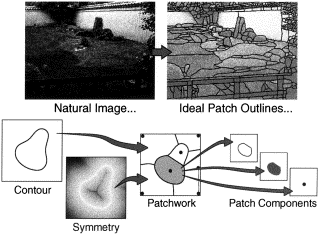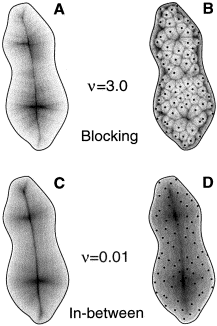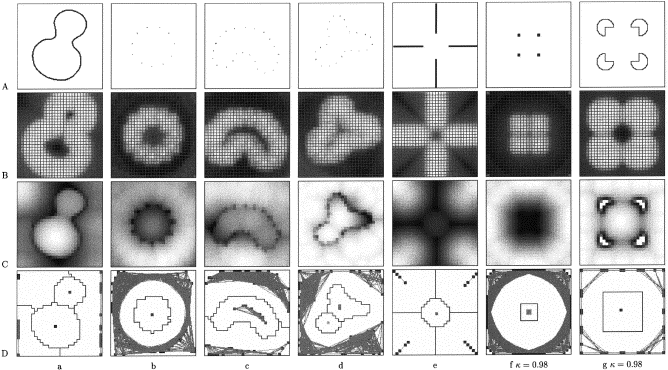Sept. 15, 2005
BACK
Publications in Landscaping,
the analysis of Gardens, Perception and Medial Representations by
Landscaping and the Analysis of Gardens:
Perception:
- From image segmentation to anti-textons, 2000.
- Bottom-up clues
in target finding: Why a dalmatian may be
mistaken for an elephant, 2000.
Medial Representations:
BibTeX references.
Recovery of Visual
Structure in Illustrated Japanese Gardens
Order and Complexity
of Naturalistic Landscapes: On Creation, Depiction and Perception of
Japanese Dry Rock Gardens
Visual Perception in
Japanese Rock Garden Design
Flexible Computation of
Shape Symmetries Within the Maximal Disk Paradigm
IEEE Trans. SMC Part B,
33(3):535-540, June 2003.
(Transactions on Systems, Man and Cybernetics; Part B: Cybernetics)
Abstract
Shape symmetries, like medial axes, contain a wealth of information
useful in engineering and many different models for symmetry
computation have been proposed. We present the hybrid symmetry
transform (HST) as a compactly
reformulated version of the maximal disk
methods. HST is inspired by shunting inhibition networks and general
concepts in wave dynamics. Through adjusting a shunting coefficient,
the strength of adherence to the maximal disk paradigm becomes tunable.
Each image location is scanned with a set of concentric rings which are
then combined via weighted (shunting) summation, as opposed to the
winner-takes-all approach in strict maximal disk methods. The new model
is simple yet operates flexibly to compute maximal disk symmetries in a
variety of conditions, interpreted as different wave propagation modes.
Visual Structure of a
Japanese Zen Garden
G.J. van
Tonder, M. J. Lyons and Y. Ejima
Nature, no.419, pp. 359-360, Sept.
2002.
Abstract
The dry landscape garden at Ryoanji Temple in Kyoto, Japan, a UNESCO
world heritage site, intrigues hundreds of thousands of visitors every
year with its abstract, sparse and seemingly random composition of
rocks and moss on an otherwise empty rectangle of raked gravel. Here we
apply a model of shape analysis in early visual processing to show that
the 'empty' space of the garden is implicitly structured and critically
aligned with the temple's architecture. We propose that this invisible
design creates the visual appeal of the garden and was probably
intended as an inherent feature of the composition.
Web links:
The Patchwork Engine: Image
Segmentation from Image Symmetries
G.J. van Tonder and Y.
Ejima
Neural Networks, Vol. 13, No. 3, pp. 291-303, April 2000.

Fig. 1. Schematic of the patchwork engine:
A visual scene (left upper
half) is ideally transformed
into a pattern of patches (right upper
half)
which correspond to shape sub-parts.
The schematic shows what
ideal patches consist of.
Abstract
We propose blind segmentation of images into shape-related 'patches'
based on pre-calculated local symmetries (Van Tonder, G.J. & Ejima,
Y. (1999). (Forthcoming a) Flexible computation of shape symmetries.
Submitted for publication) in shape boundary contours. First, lateral
weights between all points in the boundary contour map are assigned
analogous to Euclidean distance maps in watershed segmentation
(Beucher, S. & Lantejoul, C. (1979). Use of watersheds in contour
detection. Proceedings of the International Workshop on Image
Processing, CCETT, Rennes, France.). Lateral weights are then used to:
(1) extract local maxima in symmetries; (2) link maxima within locally
enclosed boundary contours; and (3) reconstruct shape contours using
symmetry maxima as 'seeds'. The new model overcomes weaknesses of
watershed segmentation. The new model closes gaps in relatively more
solid image contours, but it is fundamentally different from methods
based on contour interpolation (Grossberg, S., Mingolla, E. &
Todorovc, D. (1989). A neural network architecture for preattentive
vision, IEEE Transactions on Biomedical Engineering 36, 65-84; Heitger,
F. & von der Heydt, R. (1993). A computational model of neural
contour processing: figure-ground segregation and illusory contours.
Proceedings of the Fourth International Conference on Computer Vision,
IEEE Computer Society Press, Washington D.C. (pp. 32-40)). Images are
segmented into shape-relevant color-by-number-like patches which
compare well to related methods (Gauch, J. & Pizer, M. (1993). The
intensity axis of symmetry and its application to image segmentation,
IEEE Transactions on Pattern Analysis and Machine Intelligence, 15 (8),
753-770; Ilg, W. & Ogniewicz, R. (1995). The application of Voronoi
skeletons to perceptual grouping in line images, Proceedings of the
11th International Conference on Pattern Recognition, The Hague, The
Netherlands, pp. 382-385; Zhu, S.C. & Yuille, A.L. (1996) FORMS: a
flexible object recognition and modeling system, International Journal
of Computer Vision, 20 (3), 187-212.). Two primitive operations,
comparison and merging of patches, are proposed as drives for exposing
more global shape contours from patches. We conclude that symmetry goes
beyond abstract shape morphology: it can contribute to figure-ground
segmentation in early vision and form part of primitive operations
needed to create hypotheses of complex shape.
Fig. 2. Hand-drawn reproductions from
Blum's (
Blum,
1973)
explanation of how (a) superposition versus (b) blocking waves
propagate,
and how blocking waves (c) trace out
the symmetry axis of a
triangular boundary.
(d) Three different maximal disks, centred
on the
symmetry axis (dotted line) of a shape.

Fig. 3. Consider the slug shape above. With ν=3 the maximal disk
paradigm,
or blocking wave mode, is strictly followed (A), which fails
to give
more global symmetries of contours when noise elements are
introduced (B).
With ν=0.01 the HST operates in between classical and
blocking wave modes.
It gives desired symmetries both in the absence
(C) and presence of noise (D).
Dark pixels indicate strong symmetry
activation. Image contours

were
superimposed on computed symmetries as black lines and dots.

Fig. 10. More examples of patchwork segmentation. Again, high
resolution input
images

are
shown in row A,

in row
B.

are in
row C and
patchwork patterns in row D.

Fig. 11. A texture image (left) and its patchwork (middle).
Patches
were shaded according to the average pixel
difference with neighbouring
patches (right).
Large differences are plotted darker. ρ=15.

Fig. 12. Input texture images (top), patchwork patterns (middle)
and
patch difference (bottom). (D) is obtained via texture element
by
element scaling of (A). The visible target in (A) has similar patches,
showing up as a white region (C), whereas the target visible in (D)
is
dark (F) due to irregularity of its constituent patches.

Fig. 13. A medical scan image (A) and Canny edge map (B) after (
Ilg
& Ogniewicz, 1995).
(C) shows the patchwork of (B). (D) and (E) shows 71 patches and a grid
of 81 Cartesian boxes, respectively, with patches and boxes shaded
with
the average grey scale value of their overlapping image pixels.
From image segmentation to
anti-textons
Abstract
We apply the 'patchwork engine' (PE; van Tonder and Ejima, 2000 Neural
Networks forthcoming) to encode spaces between textons in
an attempt to find a suitable feature representation of
anti-textons [Williams and Julesz, 1991, in Neural Networks for
Perception volume 1: Human and Machine Perception
Ed. H Wechsler (San Diego, CA: Academic Press); 1992, Proceedings
of the National Academy of Sciences of the USA 89
6531 - 6534]. With computed anti-textons it is possible to
show that
tessellation and distribution of anti-textons can differ from that of
textons depending on the ratio of texton size to anti-texton size. From
this we hypothesise that variability of anti-textons can enhance
texture segregation, and test our hypothesis in two psychophysical
experiments. Texture segregation asymmetry is the topic of the first
test. We found that targets on backgrounds with regular anti-textons
segregate more strongly than on backgrounds with highly variable
anti-textons. This neatly complements other explanations for texture
segregation asymmetry (eg Rubenstein and Sagi, 1990 Journal of the
Optical Society of America A 7
1632 - 1643). Second the relative significance of textons and
anti-textons in human texture segregation is investigated for a limited
set of texture patterns. Subjects consistently judged a combination of
texton and anti-texton gradients as more conspicuous than texton-only
gradients, and judged texton-only gradients as being more conspicuous
than anti-texton-only gradients. In the absence of strong texton
gradients the regularity versus irregularity of anti-textons agrees
with perceived texture segregation. Using PE outputs as anti-texton
features thus enabled the conception of various useful tests on texture
segregation. The PE is originally intended as a general image
segmentation method based on symmetry axes. With this paper we
therefore hope to relate anti-textons with visual processing in a wider
sense.
Bottom-up clues in target
finding: Why a dalmatian may be mistaken for an elephant
G.J. van
Tonder and Y. Ejima
Perception,
volume 29, number 2, pages
149 - 157,
Feb. 2000.
Abstract
We provide informal psychophysical
support for a
strategy where bottom - up features guide attention toward a
target,
and the top - down path interprets hypothetical shapes at the
target
location -- as opposed to a dominant top - down
approach. In our
survey, for which we used the familiar picture of a Dalmatian dog
against a dappled background, (i) 75% of subjects initially found a
bulging body which overlaps that of the dog, but final
'top - down'
percepts were unexpected: nearly all subjects assigned an incorrect
head and limbs to the body; (ii) after random rotation of texture
elements overlapping computed features only 45% of subjects reported a
bulging body, with a few adding limbs etc. The picture of the Dalmatian
dog must therefore contain many bottom - up
features -- a top - down
strategy may find 'incorrect' targets at correct target locations.
Computational support for these claims is more easily constructed than
one may expect. We could compute at least two bottom - up
features,
both useful in 3-D surface interpolation from 2-D scenes, which yielded
significant values at the location of the Dalmatian dog: anisotropic
texture compression and affine texture distortion cues. We therefore
conclude that the role of top - down processing is overstated
in a
traditional example such as the Dalmatian dog picture.
BACK
Page created & maintained by
Frederic Leymarie, 2005.
Comments, suggestions, etc., mail to: ffl at gold dot ac dot uk







